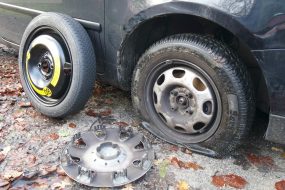
TPMS is a safety feature in newer cars that makes it safer for a car to be driven without fear of deflated tires or getting involved in an accident.
Car tires can get old and will eventually need changing, when you are changing the tires, do you need to reset the TPMS?
Yes, you need to reset or calibrate your TPMS after changing, rotating, and installing new tires to function properly, and to remove the tire pressure warning light on your dashboard.
Do You Need to Reset TPMS After New Tires?
Yes, it is important to reset the TPMS after new tires. As a matter of fact, it is usually recommended by manufacturers.
New tires may not necessarily mean you are changing the tires completely, it could be that the tires are rotated. Whichever it is, the TPMS should be reset.
To reset the TPMS simply means you are retraining or teaching the system to recognize the new positions the sensors are in
There are varying procedures to reset a TPMS depending on the car. You may need to check the owner’s manual or ask your auto mechanic for a suitable procedure to reset your car’s TPMS.
How Do You Reset TPMS After Changing Tires?
Before proceeding to reset the TPMS after the tires must have been changed, you must be sure whether your car has a direct or indirect TPMS.
Direct TPMS means the sensor can be found on the rim or tire’s pressure valve while Indirect TPMS means the sensor is on the ABS brakes.
Wherever the location of the TPMS may be, you should be able to reset it by using any of the following procedures;
1. Ensure the Pressure is Correct
The first thing to ensure before trying to reset the TPMS is the tire pressure. You can determine the tire pressure by using a tire pressure gauge.
To get the right PSI, inflate the tire and then deflate. This should be done a couple of times and the car driven at 15mph in order to manually calibrate the sensors
2. Use the TPMS Reset Button
In cars with direct TPMS, you will most likely find the TPMS reset button under the steering wheel although depending on the car type and model the reset button can be located in different places.
Once the button has been located, put the car key in its ignition then turn the battery but do not start the car. Proceed to push down the reset button for at least 3 seconds. You can then start the car and drive for at least 20 minutes before turning off the ignition.
3. Drive the Car at 50mph
Another way to reset the TPMS after changing tires is to drive at 50 mph. Driving the car at 50 mph for 10 miles is a good and easy way for the sensor to recalibrate itself.
50 mph may be too slow for some cars which is why it is important to know what works for your car. This method will most likely work in cars with indirect TPMS.
4. Use the TPMS Reset Tool
TPMS tool helps you to reprogram the sensor in case they have lost their information. You can as well reset the TPMS light by using the reset tool.
There are various types of TPMS reset tools so you may have to make proper findings to know the one that will work.
5. Remove the Car Battery and Re-connect
You can also reset the TPMS after changing tires by simply disconnecting the car battery and reconnecting it. To remove the battery, first, remove the negative terminal then press the car horn to drain out the remaining power.
How Long Does TPMS Light Stay on After New Tires?
The TPMS light should go off within several minutes after installing the new tires. However, if the warning light refuse to go off, you can perform a reset to remove the light.
Can I Use the Same TPMS on My New Tires?
Yes, you can use the same TPMS on your new tires as long as they are still in good condition. There is no need replacing the sensor when its still working very fine. However, if the sensor has gone bad, you can go ahead and change it.
Pros of Resetting TPMS After New Tires
Resetting the TPMS after getting new tires is very important and here are some advantages to doing so:
- Extend the Tire’s Life: One of the many advantages of resetting the TPMS is that it extends the tire’s life. A car’s tire is the only part that touches the ground and should therefore be in good condition. Therefore, resetting the TPMS is a good way to keep the tires in use for longer.
- Fuel Saving: Resetting the TPMS also helps to save fuel, the car doesn’t consume too much fuel. Resetting the TPMS is like retraining it to know the new sensor location, if this is not done wrong information in the sensor will result in excessive fuel consumption by the tire and car.
- Reduce the Risk of Accidents: An under-inflated tire is a recipe for accidents. When a tire is under-inflated and it is not remedied in time the chances of getting involved in an accident are high.
However, this can be averted by simply resetting the TPMS after the tires have been changed. Resetting the tires makes it safer to drive a car even with new tires in place.
Conclusion
Although there are different procedures to reset the TPMS, some of which are quite easy. If you have done all you can in trying to reset it and nothing seems to be working, you should take the car to an auto shop and have it done.









